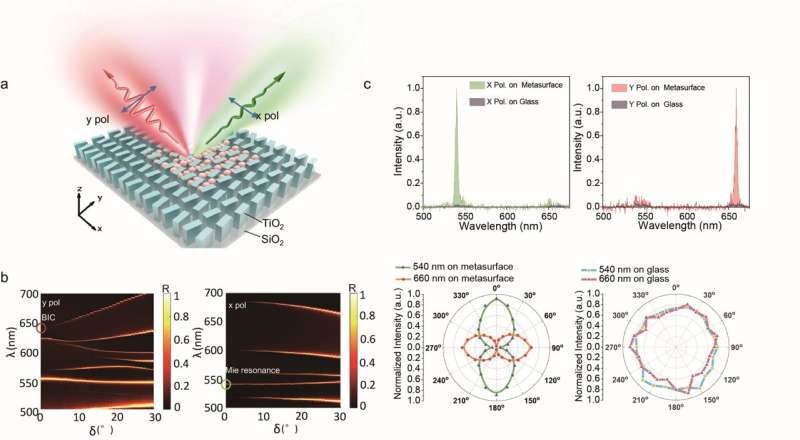This article has been reviewed according to Science X's editorial process and policies. Editors have highlighted the following attributes while ensuring the content's credibility:
fact-checked
peer-reviewed publication
trusted source
proofread
Upconversion photoluminescence appears to shine polarized and brighter

Lanthanide-doped upconversion nanoparticles (UCNPs) demonstrate many superior properties of broadly-tunable multicolor emission and long emission lifetimes. This makes them well-suited for many light-emission applications. Despite many advantages, the further progress and practical applications of UCNPs face significant challenges.
Polarization is another important characteristic of fluorescence. It provides orientation and structural information in an additional dimension. Polarization has been extensively employed in the fluorescence polarization imaging technique. The inherent upconversion emission processes associated with the 4f electronic transition in UCNPs are typically weak and do not exhibit polarization characteristics.
In a new paper published in eLight, a team of scientists led by Professors Xiangping Li and Zi-Lan Deng (Jinan University), Junjie Li (Institute of Physics, CAS), Yuri Kivshar (Australian National University) have developed a dielectric metasurface for the amplification of upconversion emissions.
Most previous studies focused on enhancing the upconversion luminescence by coupling UCNPs with plasmonic nanostructures. The concentrated electromagnetic field near these nanostructures can significantly boost the absorption cross-sections and the upconversion radiation rates. Metallic structures supporting surface plasmons effectively localize light and create strong electric fields, enhancing upconversion fluorescence.
Due to intrinsic loss, metallic nanostructures generally have low-quality factor (Q factor) values. They may cause a quenching effect due to direct contact with the emission materials. The Q value is a crucial parameter for resonant excitation. The typical range of Q factor for plasmonic resonances is up to a few tens. Some special designs like metal-insulator-metal (MIM) structures can obtain a high Q factor. The emitters are close to the metallic surface. The quenching effect makes the quantum efficiency drop rapidly.
Compared to plasmonic nanostructures, all-dielectric resonant metasurfaces composed of high-index dielectric nanostructures with low losses at visible frequencies support much richer multipolar Mie-resonances. It provides an excellent alternative to fluorescence enhancement.
Collective high-Q resonances emerge due to coupling these Mie multipoles in periodic arrays. Breaking the symmetry of meta-atoms can transform bound states in the continuum (BICs) into a quasi-BIC with finite but extraordinarily high Q factors. These emerging concepts have recently been well-exploited and demonstrated for fluorescence enhancement and low-threshold lasing applications.
The research team utilized the emerging concept of high-Q collective modes of resonant metasurfaces for polarization-controlled dual-band upconversion bursts. The team designed and fabricated high-Q resonant metasurfaces composed of diatomic nano bricks. The design supports a quasi-BIC mode for the y-polarized incidence and another high-Q Mie resonance mode for the x-polarized incidence. NaYF4:Yb/Er UCNPs deposited on the metasurface exhibit ultrabright upconversion luminescence at dual bands.
By controlling the rotation of the polarization analyzer, the team demonstrated linearly- and cross-polarized emission at dual bands with ultra-high degrees of polarization (DoPs). The demonstration paves the way for efficient enhancements and polarization control of the UCNP emission with potential applications in low-threshold polarization upconversion lasers and hyperspectral imaging/sensing.
More information: Ziwei Feng et al, Dual-band polarized upconversion photoluminescence enhanced by resonant dielectric metasurfaces, eLight (2023). DOI: 10.1186/s43593-023-00054-2
Journal information: eLight
Provided by Chinese Academy of Sciences





















